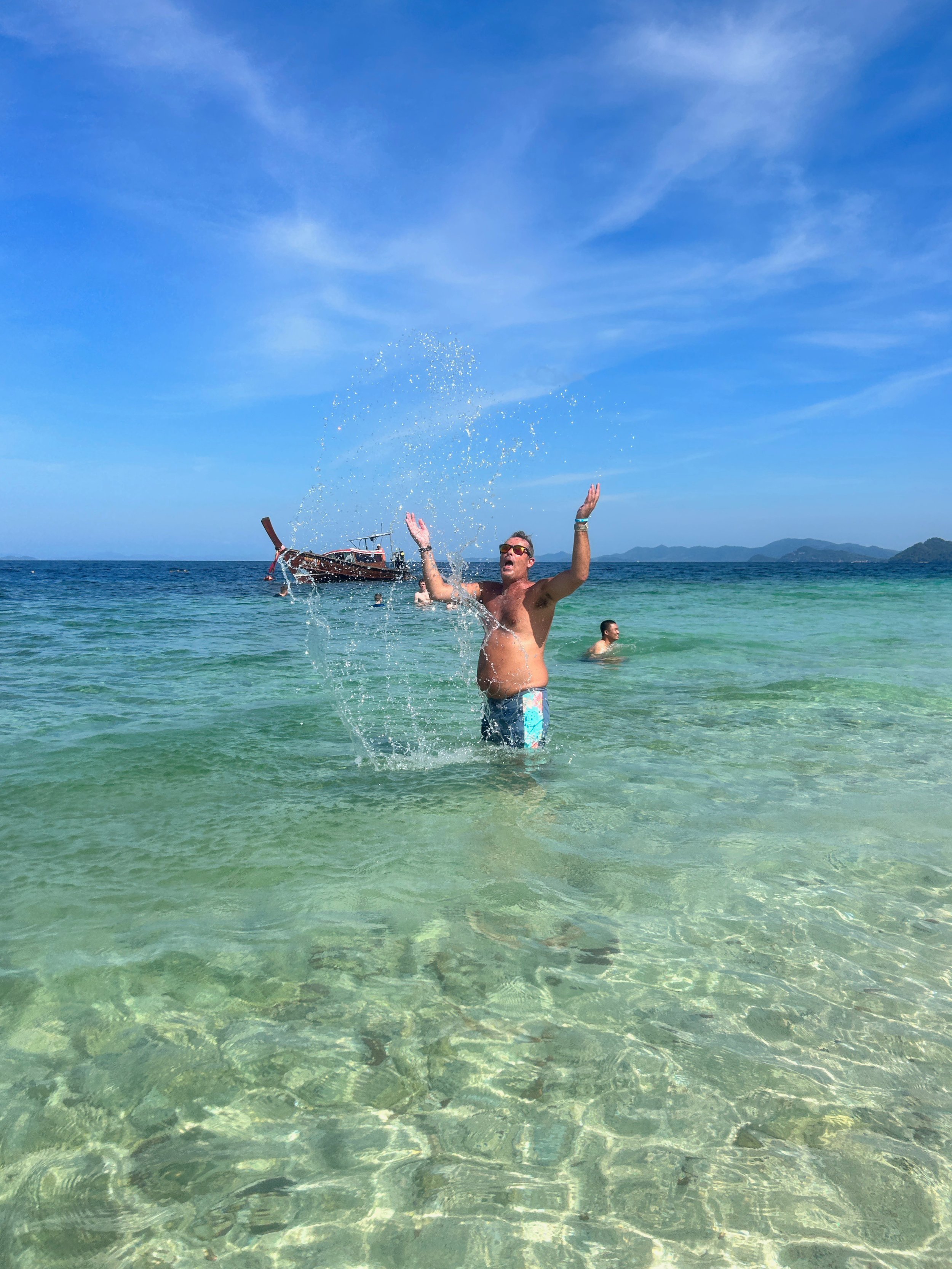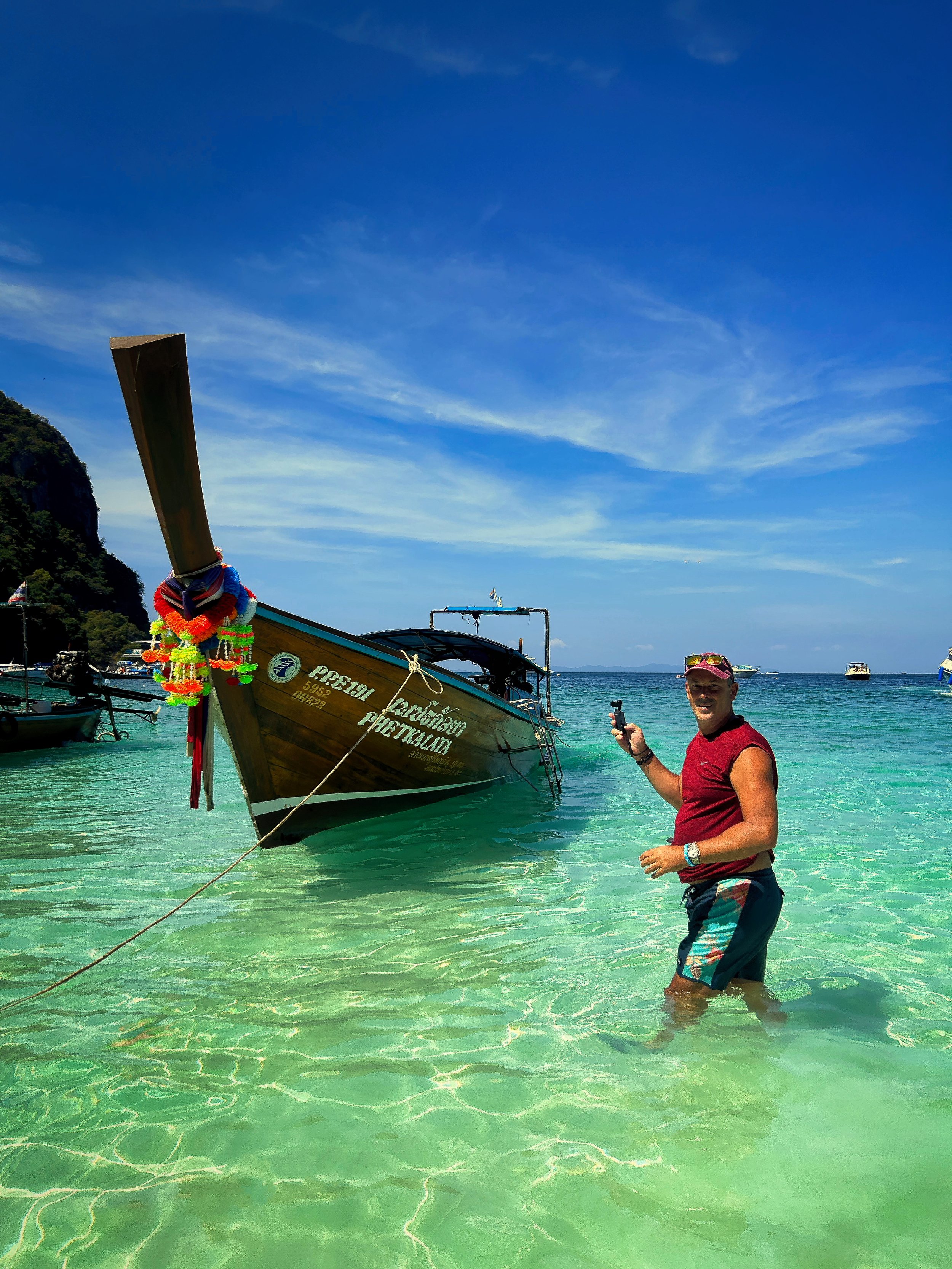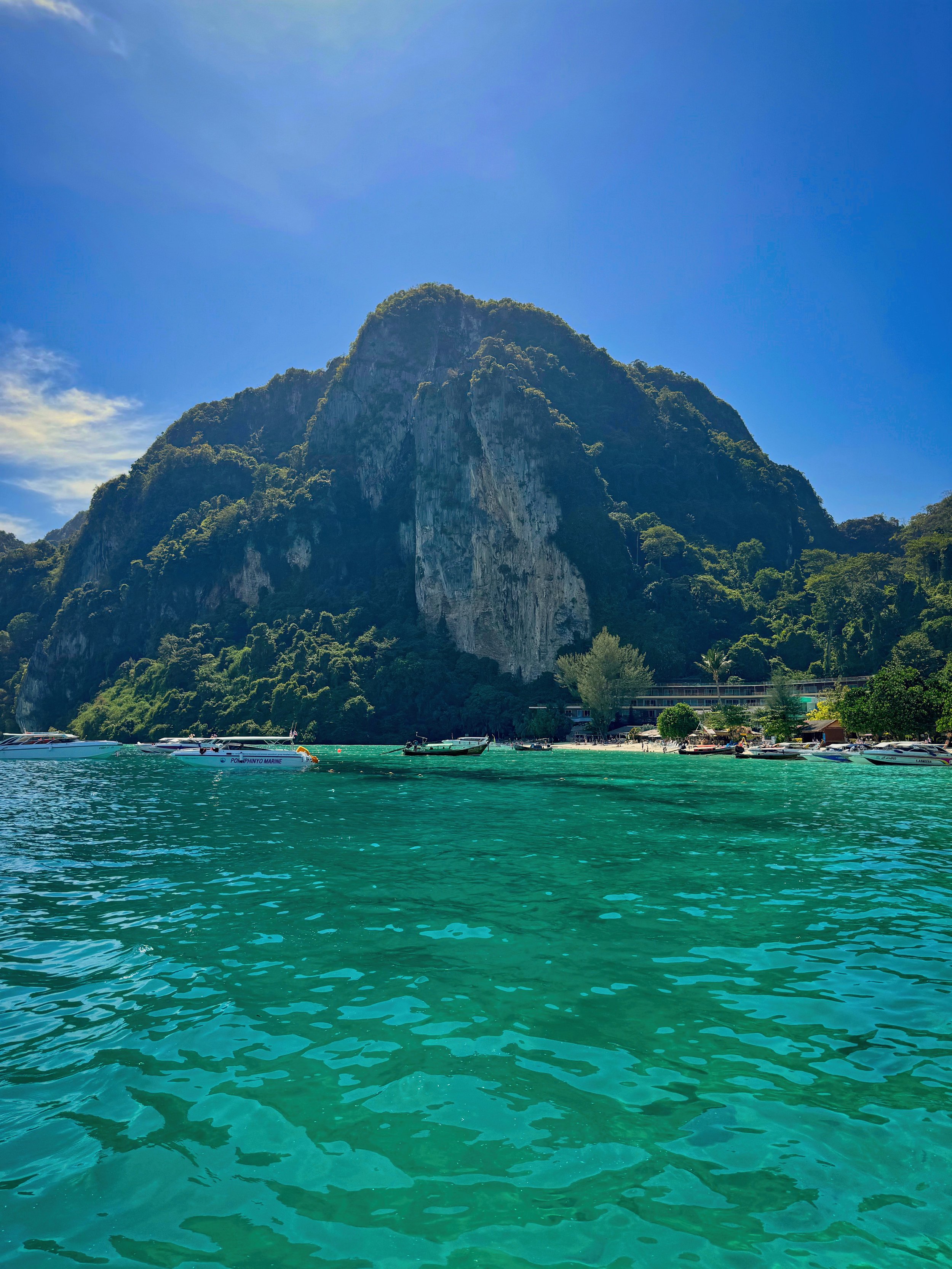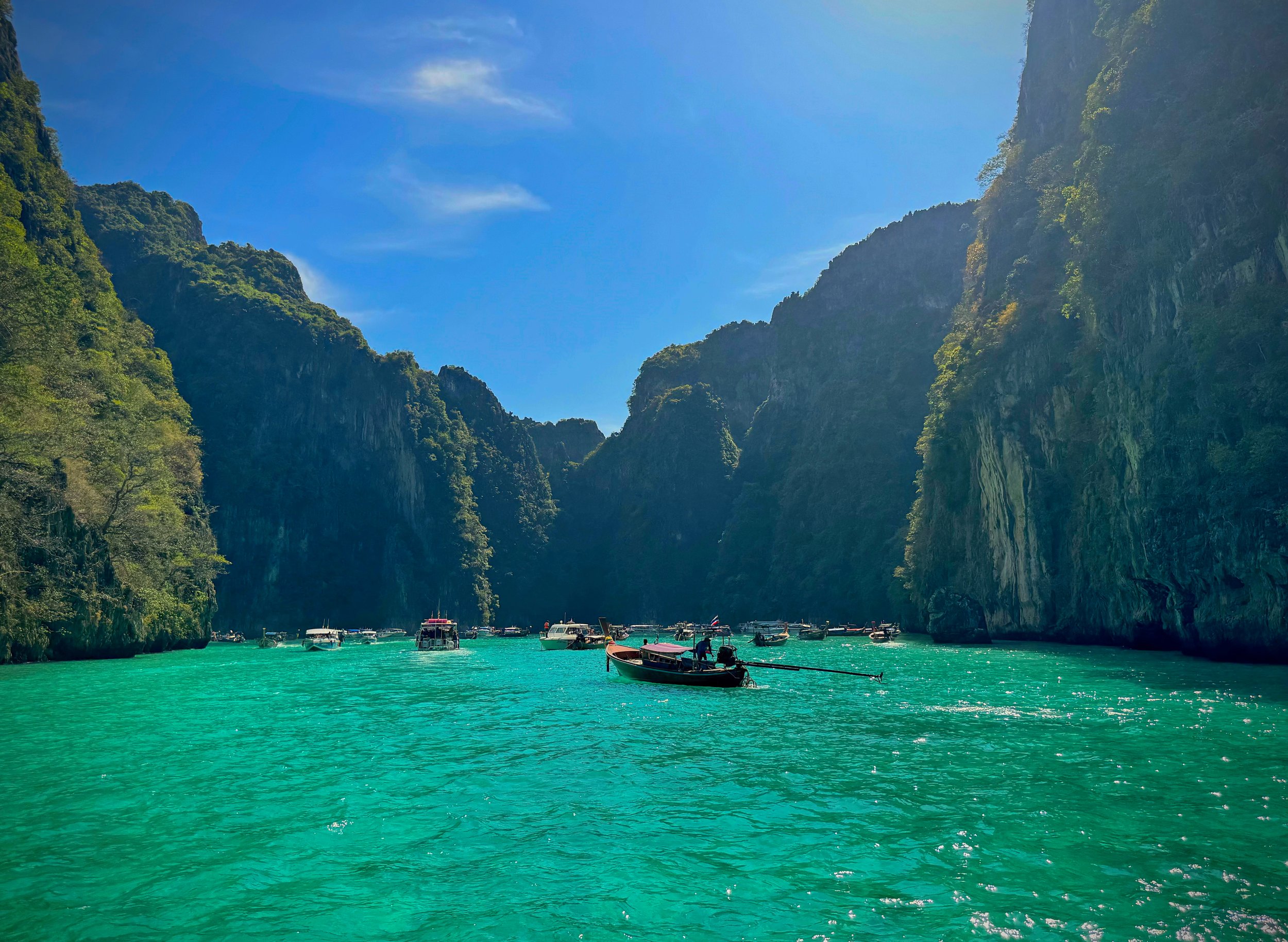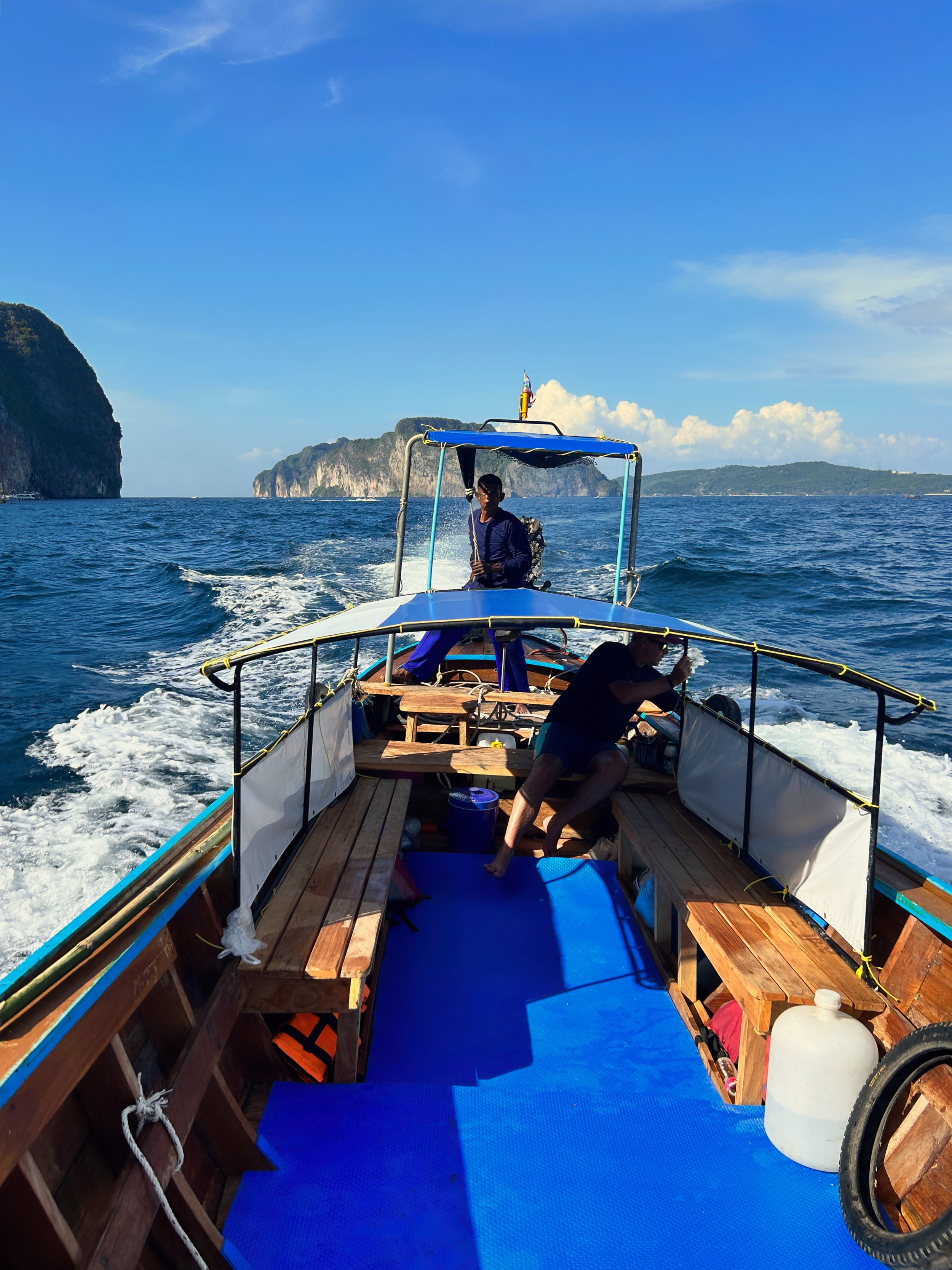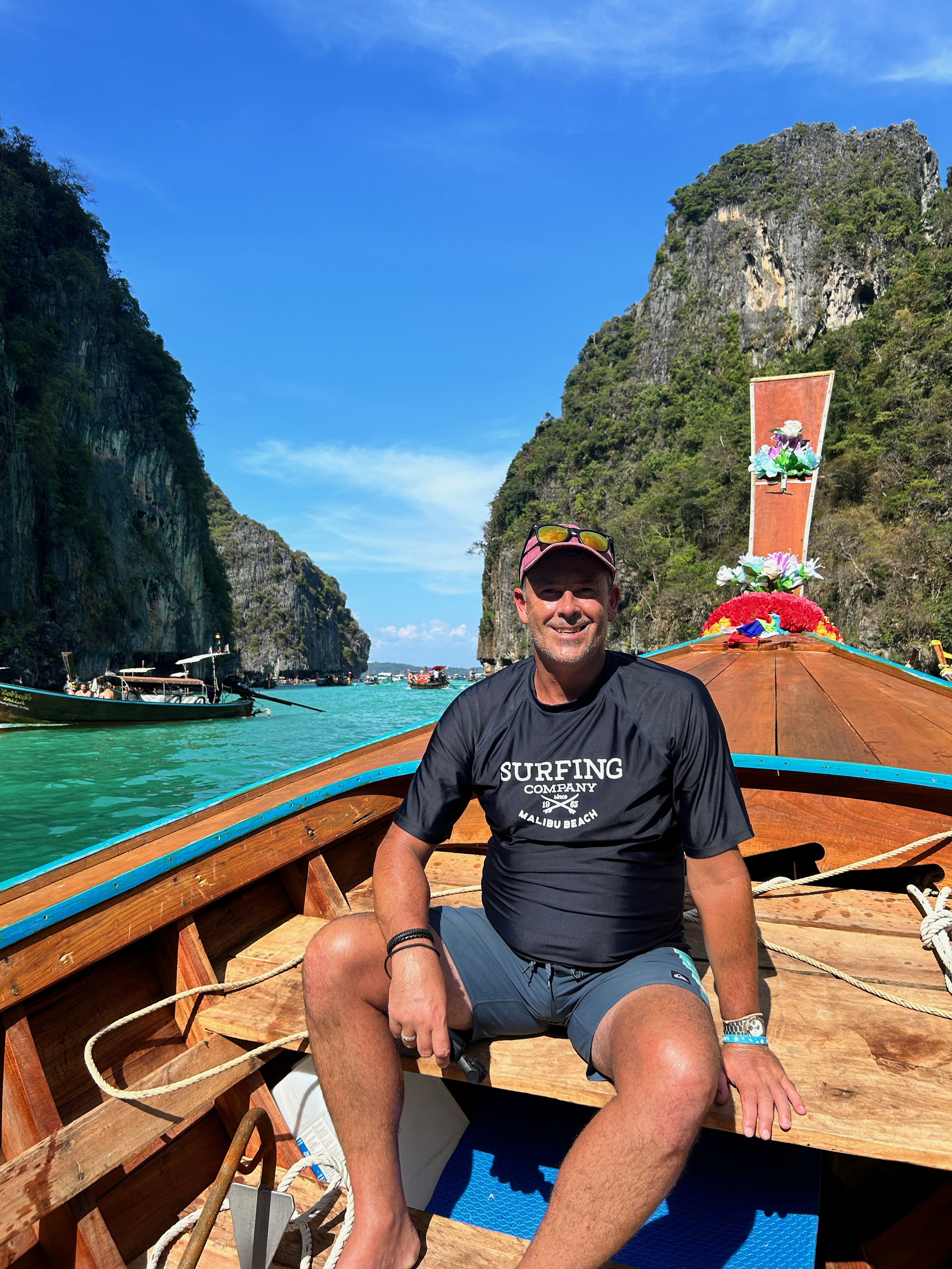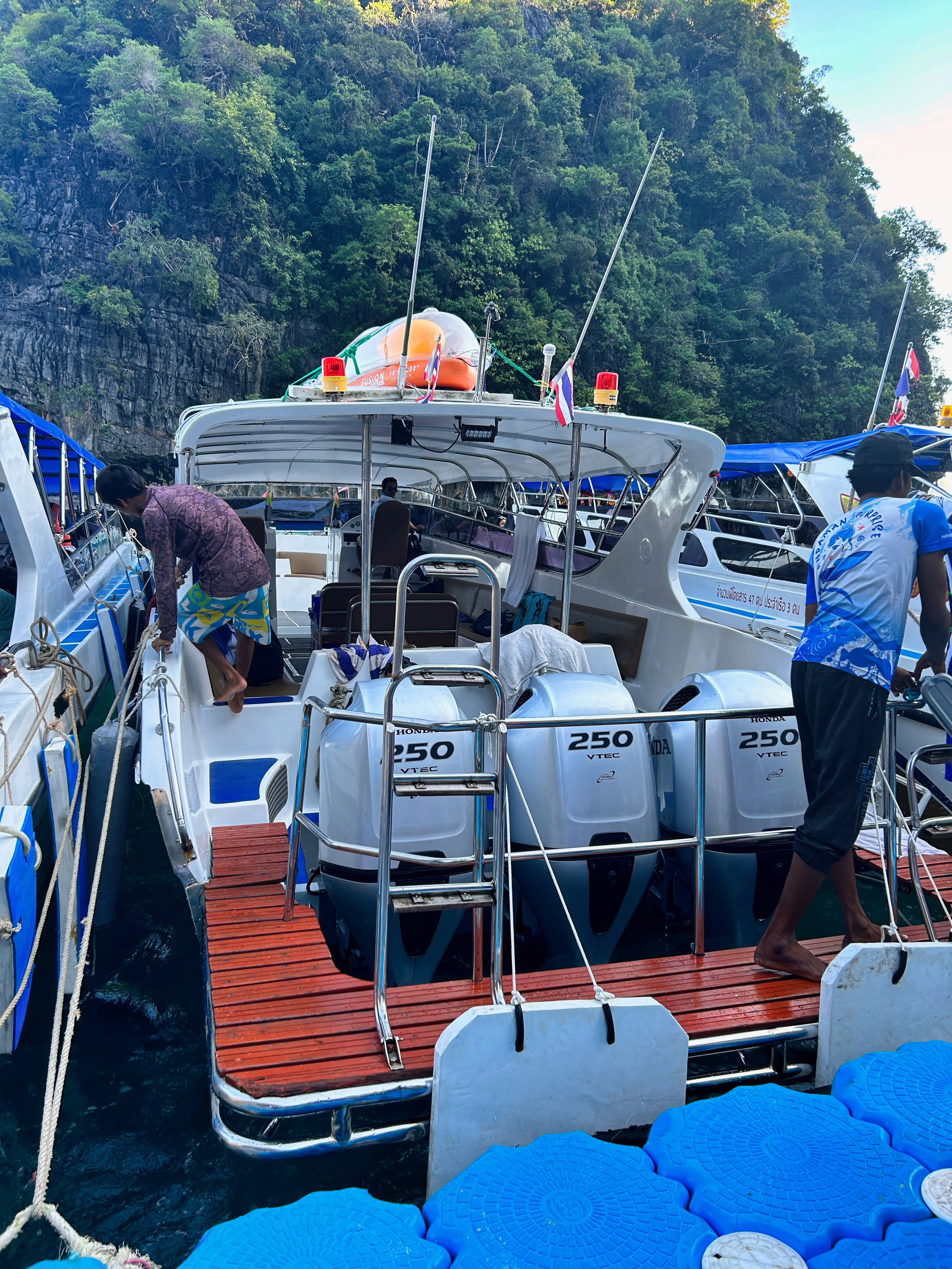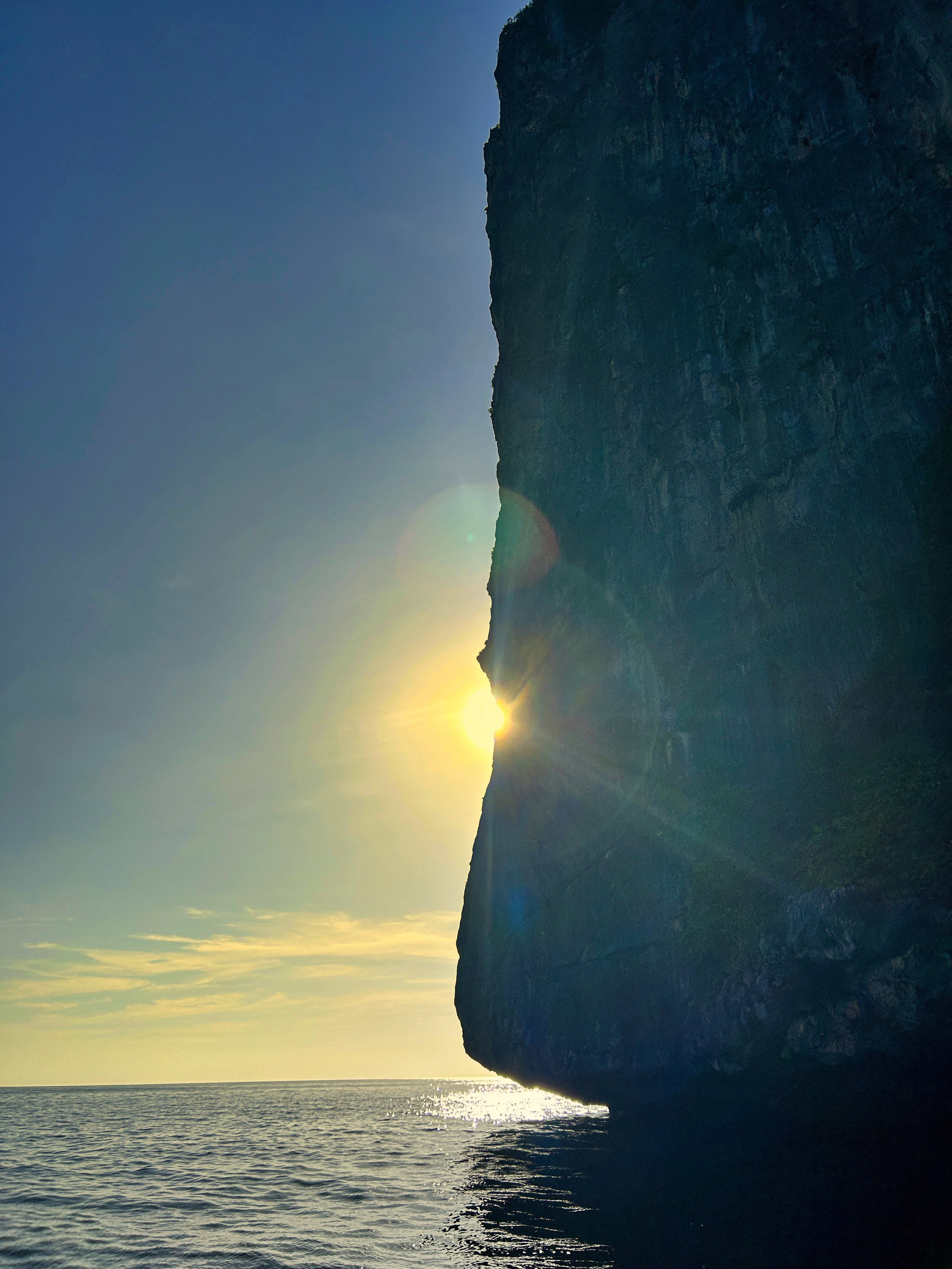Phi Phi Islands
It’s probably safe to say most visitors to Phuket will arrange at least a day trip to the Phi Phi Islands. Sitting about 45km off Phuket in the Andaman Sea a group of 6 islands form the Phi Phi Islands National Park. Comprising 2 large islands, Koh Phi Phi Don and Koh Phi Phi Le and 4 smaller islands not much more than large limestone rocks jutting out of the sea, they were formed millions of years ago but only first populated in the 1940’s. The archipelago slowly gained tourist popularity in the 1990’s but skyrocketed with the release of the Leonardo DiCaprio movie The Beach in 2000.
Fatpaps’ adventure started again with a morning pick up at the hotel in what could well have been the same minibus as before. After a 40 minute drive to the other side of the island he arrived at the Royal Phuket Marina. Here multiple operators running multiple vessels gathered on the docks to coordinated the bedlam. Sign this, waiver that and put on this coloured wrist band. It was a right kerfuffle only making some sense when learning more about the day ahead and the island chains history.
The charter selected when booking the day before was Andaman Surprise who boasted not only a superior modern fleet, but an all-inclusive package for the day with the exception of sunburn and crowd control. Right from the offset they were friendly and efficient and you quickly realised the day was gonna be a good one.
First port of call after a 30 minute dash across the Strait of Malacca was Koh Khai Nai, a small sandy isle part of another chain. The trip out was calm and pleasant and having chosen a seat in the open bow section of the boat Fatpap basked in the sun with the wind in this hair. Upon arrival however a picture of the expected crowds for the day became evident with already a dozen similar boats anchored up on shore with their cohorts already disembarked.
Khai Nai is a picture postcard with white sand and crystal clear waters but nothing short of a tourist trap. Beach chairs can be rented, drinks can be bought, jet skis and snorkelling gear hired. But with only 40 minutes allowed at this stop Fatpap barely had time to send up Derek (the drone) and have a swim. Regardless, the island was spectacular (even with people) and the day already absolutely stunning.
Relaxed, albeit a little rushed, we boarded again for another short streak south toward Phi Phi Don and some much anticipated snorkelling. The location is usually determined by the guide on the day based on his preferences and today a favourite alcove on the very southern tip of the island was selected. The boat masterfully reversed into position and expertly moored onto the permanent buoys and before long all participants were jumping off the bow. The water was clean and warm with the outline of coral clearly visible below. Those surrounding the Phi Phi Islands are filled with exotic marine life including docile Leopard sharks, however today they were sadly absent. There was in fact more swimmers than fish but many sightings of the almost plague like Orange Jacketed Russian Sea Pest could be had at every turn. But that’s often the case in crowded tourist locations. Unfortunately no exotic equatorial marine oddities were spotted but there were plenty of Angel and Coral fish making the experience worthwhile.
Back on board, the SS Andaman shifted a few hundred metres before beaching itself onto the sheltered cove of Ao Ling, more colloquially known as Monkey Beach. Home to a colony of Long-Tailed Macaques monkeys with reputedly more front than Gowings, much had been heard of this place and duly much expected. Of course the location was breathtaking but seething with more humans than primates and those that bothered to raise an eyebrow did so with as much contempt as Fatpap had for the crowds. But the little rascals scurried to and fro regarding the throngs of tourists merely as a vehicle for their much sought after banana intake. Again, this was a unique experience only adding to an already spectacular day not yet even halfway through.
Ao Ling Bay, Phi Phi Don Island, Thailand
Nearing midday it was time for lunch and time to visit Phi Phi Don’s largest settlement Ton Sai. As the only populated island of the group, all hotels, restaurants, shops and bars are located here and accessible only by ferry, speedboat or long-tailed boat. Ton Sai - translating to Banyan Tree in English - is built on a sandy isthmus less than 7 feet above sea level between two long & tall limestone ridges with semicircular beach lined bays either side. In 2004 the tsunami hit from both bays meeting in the middle of the isthmus, one wave 10 feet high, the other 21, swelling an estimated population of 10,000 people and wiping out 70% of the infrastructure. 850 bodies were recovered with another 1,200 missing but locals cite the truer number to be 4,000 souls lost.
Now fully rebuilt Ton Sai features a vibrant nightlife containing dozens of bars, restaurants and a maze of shops. Our tour however was resigned to an open aired pavilion again with shared tables and buffet style lunch. As bland as that may sound it was outstanding and ever so casual. Fatpap chatted with a father and son from Tel Aviv adding yet another dimension to the day.
After lunch a stroll along the beach front promenade mirrored Patong’s but on a more casual basis. This is what Patong must have been like perhaps 30yrs ago and was quickly concluded a 4th visit to Phuket need only be to Phi Phi Don. The island was significantly more laid back and so easy going it was a pity the tour only allowed 1hr total on the isthmus.
Phi Phi Don Island, Thailand
The Phi Phi Islands, as well as others of nearby Krabi and Phang Nga, were part of the world's biggest coral reef that occupied the area some 200 million years ago. Sea levels at the time were 300m higher and the reef stretched in a massive semicircle from Sumatra all the way up to China's Guilin. When these seas subsided, the reef emerged to the surface. Over time it was then eroded by the rain, sun and wind to form the dramatic limestone cliffs, mystical caves and beautiful beaches this part of the Andaman coast is famed for.
Heading due south the next stop was Pileh Lagoon found on the northwest side of Phi Phi Leh accessible only via a narrow entrance guarded by towering limestone cliffs. Entering the lagoon the sun perfectly lit the turquoise waters that deepened to darker shades of emerald at the centre with the surrounding cliffs creating a natural amphitheatre. Although crowded, this place was simply stunning and quintessentially what most come to expect of a Thailand island. The skipper moored the boat yet again and while others swam and kayaked, Fatpap pre-arranged a private long-tail charter through the lagoon. Partly to get away from the crowds but mainly to see this magnificent place a little closer up.
Pileh Lagoon, Phi Phi Leh Island, Thailand
Long-tails are a watercraft native to Southeast Asia using an automotive engine as its power plant. There is much variation among their design but the sole defining characteristic is a second-hand car or truck engine with an extra long propellor shaft mounted at the rear. Leaving the hoards behind the unique wooden vessel chugged its way through the crystal waters finding a private alcove to first have a swim. From there it headed out of the inlet toward the Viking Caves which are an ancient limestone cave system some 3.2 square kilometres in size. It is home to one of the world’s fastest flying birds called Swifts that build tiny white nests in the most inaccessible places within the caves. Regarded as one of the most expensive food ingredients in the world, selling for US$2,500 per kilo due to its scarcity and nutritional value, it is the key ingredient to birds’ nest soup and a thriving industry has been built around this cave. Consequently, it is not open to the public.
An hour later after some more exploring and another swim we returned to the speedboat for departure to the last, and perhaps most spectacular stop of the tour.
Just around the corner lay the gateway to perhaps one of the most famous beaches in the world, Maya Bay. Coming to worldwide prominence when used as a location for the 2000 movie The Beach, the region has seen tumultuous change ever since. The film company reportedly damaged some of the island's environment, however a massive increase in tourism as a result of its success has contributed even more to its environmental degradation. During its peak the bay saw 8,000 visitors a day with over 200 boats entering its harbour damaging both the coral reef and sandy shores. A decision by the government in 2018 to close the bay indefinitely was not taken lightly and seen as the only way to allow the environment to recover and regenerate, ensuring future generations could equally enjoys its beauty. Reopening in January 2023 under very strict conditions, Fatpap was, it could be said, lucky to see this natural marvel at all.
Maya Bay, Koh Phi Phi Leh, Thailand
One of the newly imposed reopening conditions was entry to the beach via nearby Loh Samah Bay with only a limited time allowed in the area. Here a pontoon has been installed for boats to alight their guests and a boardwalk constructed through a lushly tropical rainforest area leading to the bay itself. All good in theory but add 5,000 people and 100 boats into the equation and things can get a little frenzied. Navigating the havoc though the visitor enters a natural lyceum of million year mountainous limestone cliffs with an arching beach of sand the colour of snow and just as fine. The shallow bay holds some of the most bluest and clearest waters ever encountered and with the setting western sun playing off the eastern cliffs so late in the afternoon, the golden hour hue a photographer covets bounced from every surface.
Maya Bay was simply magnificent and in truth, breathtaking.
The closure though came with objectives. Coral rehabilitation programs, waste management strategies and the establishment of sustainable tourism practices. And since reopening rules have been enforced including an annual park closure during August and September. More than 1,000 tourists arrive onto The Phi Phi Islands daily not including day trippers. They produce up to 40 tonnes of solid waste a day with most going directly into the ocean - untreated. These islands could perhaps be the perfect example of man’s struggle between wealth and happiness and our salient need of finding balance between both.
Since the tsunami Phi Phi has come under greater threat from mass tourism and currently being campaigned to have tourist numbers capped before its natural beauty is completely destroyed. "Economically, a few people may be enriched, but their selfishness will come at great cost to Thailand and the world", says Dr Thon, an environmentalist and marine biology lecturer at Kasetsart University.
Fortunately the imposed reopening restrictions included no more than 300 people on the beach at any time but unfortunately no entering the water past the ankles. Regardless, Leopard Sharks patrolled the shallows and the intended coral rejuvenation could be clearly seen in the transparent waters. Maya Bay is honestly one of the most beautiful natural environments ever seen, however as a negative, slightly anti-climactic given the crowds. Southeast Asia’s Mona Lisa in many ways, the hoards wishing to experience the beauty paradoxically take that very beauty away.
But Phi Phi time is short and after maybe only 30 minutes we were ushered back to the docks for the return to Phuket. That was another tedious process but northbound again with the sun setting on the horizon one could only reflect on what was in truth an absolutely wonderful day on the Andaman Sea. The tour was amazing and the day an absolute highlight, however as Fatpap doesn’t do crowds very well, and if ever given a do over, perhaps something a little less “orchestrated” would be preferred. A private long-tail based out of Phi Phi Don over a few days might be more the pace.
But the Phi Phi Islands are everything the brochures and friends say they are. A must see whenever in Thailand no matter how attempted.











